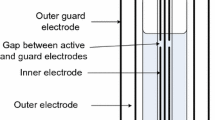Abstract
—A large number of geophysical applications need long-term telluric recordings. In order to realise it correctly, the use of very stable electrodes is necessary. The study of the potential variations of Pb-PbCl2 electrodes as a function of both the ionic composition and the pH of its electrolyte allows one to chose the optimal working criteria. The best stability and the minimum noise for the potential are obtained for a solution saturated in both salts PbCl2 and KCl, or PbCl2 and NaCl, in the presence of additional non-dissolved salts, with a pH from 4 to 5. The study of the salts diffusion between the inside of the electrode and the outside medium allows one to compute the time span over which the potential remains stable (t D time of dissaturation), and to know how to increase it. Two solutions are possible. The first one is to increase the electrode length, because t D is proportional to the length squared. The second one is to reduce the exchanges of salts with the external medium, by using an electrode with a narrow channel. In this case, t D is proportional to the quantity of non-dissolved salt in the electrode and to the internal electrical resistance of the electrode. The fabrication of this new electrodes design with a channel is described.
Similar content being viewed by others
Author information
Authors and Affiliations
Additional information
Received January 15, 1999, accepted June 7, 1999
Rights and permissions
About this article
Cite this article
Petiau, G. Second Generation of Lead-lead Chloride Electrodes for Geophysical Applications . Pure appl. geophys. 157, 357–382 (2000). https://doi.org/10.1007/s000240050004
Issue Date:
DOI: https://doi.org/10.1007/s000240050004




